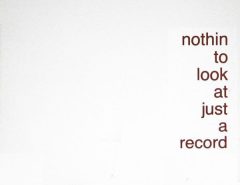Denoising Field Recordings documents an early attempt at using denoising-techniques in a creative and compositional manner. Instead of utilising noise-reduction-algorithms for their intended purpose (the restoration of damaged audio signals), these processes are applied to various field recordings of trains, streets, swimminghalls and public transport. Due to the fact that these recordings consist entirely of noises this operation transforms the originals into an uncanny hybrid of newly introduced processing artefacts, occasional silence and sporadically audible traces of the original field recordings. What kind of sound-aesthetics can emerge while denoising field recordings? Which audible parameters are able to resist this »audio-erasement-process«? How are these traces comparable to the visual remanences of Robert Rauschenberg’s erasure of a de Kooning drawing?




Leave a Reply
Lo siento, debes estar conectado para publicar un comentario.